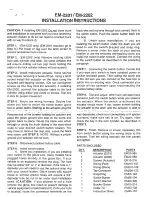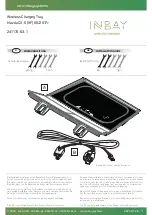
8
357
Maintenance and Care
internal damage, which may even lead
to the tire destruction.
CAUTION!
After inspecting or adjusting the tire
pressure, always reinstall the valve
stem cap. This will prevent moisture
and dirt from entering the valve stem,
which could damage it.
Impacts with curbs, holes, and
obstacles in the road, and prolonged
trips on rough roads or off-road trails
can cause tire damage which may not
be visible to the naked eye.
Check your tires regularly for any signs
of damage (e.g. scratches, cuts, cracks,
bulges, etc.). If sharp objects penetrate
the tires, they can cause structural
damage which is only visible when the
tire is removed.
In any case, any possible damage
must be inspected by an experienced
technician, as it may seriously reduce
the tire life.
Remember that tires deteriorate with
time, even if used little or not at all.
Cracks in the tire tread and sides,
alongside possible bulging, are a sign
of deterioration.
WARNING!
•
Check the inflating pressure of the
tires when cold, at least every two
weeks and before long trips.
•
Have the old tires inspected by an
experienced technician, to make
sure they can still be used safely.
If the same tire has been on your
vehicle for 4 or 5 years, have it
inspected anyway by an experienced
technician.
•
Never fit tires of uncertain origin.
•
“Directional” tires have an arrow
on their side showing the rolling
direction. To keep the best
performance when replacing a tire,
make sure that the rolling direction
corresponds to the one shown by the
arrow.
•
During the tire life, the rolling
direction used for the first fitting
shall always be observed, also in
case of “nondirectional” tires.
•
Check the depth of the tire tread
at regular intervals. The minimum
allowed value is 1.6 mm (0.06 in) or 4
mm (0.16 in) for winter, all-season
and snow tires, at that point the
wear indicators on the tire will
be visible (
: chapter “Tires
Information” in section “Safety”).
The thinner is the tread, the greater
is the risk of skidding.
•
Drive carefully on wet roads to
decrease the risk of aquaplaning.
Winter Tires
These tires are specially designed for
driving on snow and ice and are fitted
to replace the ones supplied with the
vehicle.
The functions of these tires are
significantly reduced in winter when
tread depth is less than 4 mm (0.16 in).
In this case, they should be replaced.
The specific functions of the winter
tires lead to lower performance under
normal environmental conditions or on
long highway trips, compared to the
standard tires.
Therefore, their use should be limited
to the situations and performance for
which they have been type-approved.
The
Service Network
can provide all
necessary information about fitting
winter tires on the vehicle.
NOTE:
• We recommend fitting winter tires
on the vehicle at temperatures
below 7
°
C (45
°
F) since the driving
performance of summer tires is
reduced at low temperatures.
(Continued)
Summary of Contents for Ghibli 2021
Page 2: ......
Page 3: ...Levante Owner s Manual ...
Page 6: ...4 ...
Page 12: ...10 Introduction ...
Page 67: ...2 65 Understanding the Vehicle Air Conditioning Distribution A C Dual zone ...
Page 68: ...2 66 Understanding the Vehicle A C Four zone ...
Page 98: ...96 Before Starting ...
Page 200: ...5 198 Starting and Driving SPORT ...
Page 319: ...7 317 In an Emergency NOTE Maximum work angle of towing cable or bar 15 ...
Page 320: ...318 In an Emergency ...
Page 372: ...370 Maintenance and Care ...
Page 381: ......
















































